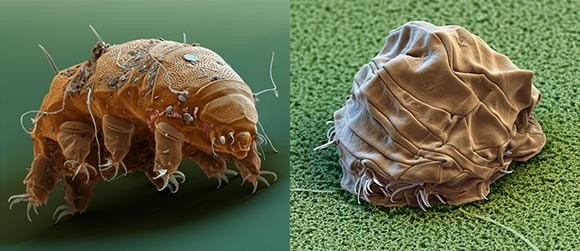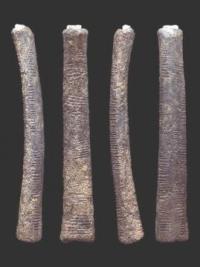Extremophiles

EXTREMOPHILES are organisms that require extreme environments for growth. While this is perhaps self-evident, what constitutes extreme? Extreme, is a relative term, with the point of relativity being what is normal for humans. Extremophiles are therefore organisms that are "fond of" or "love" (-phile) environments including high temperature, pH, pressure and salt concentration, or low temperature, pH, nutrient concentration, or water availability.
Extremophiles are also organisms that can tolerate extreme conditions including high levels of radiation or toxic compounds, or those living in conditions that we consider unusual, such as living in rocks 1.5 km below the surface of the earth. In addition, extremophiles may be found in environments with a combination of extreme conditions such as high temperature and high acidity or high pressure and low temperature.
Terms used to describe extremophiles include the following:
- Alkaliphile: An organism with optimal growth at pH values above 10.
- Barophile: An organism that lives optimally at high hydrostatic pressure.
- Endolith: An organism that lives in rocks.
- Extreme Acidophile: An organism with a pH optimum for growth at, or below, pH 3.
- Extremophile: An organism that is isolated from an extreme environment and often requires the extreme condition for growth. Extreme is anthropocentrically derived.
- Halophile: An organism requiring at least 0.2M salt for growth.
- Hyperthermophile: An organism having a growth temperature optimum of 80 °C or higher.
- Oligotroph: An organism with optimal growth in nutrient limited conditions.
- Psychrophile: An organism having a growth temperature optimum of 15 °C or lower, and a maximum temperature of 20 °C.
- Toxitolerant: An organism able to withstand high levels of damaging agents. For example, living in water saturated with benzene, or in the water-core of a nuclear reactor.
- Xerotolerant: An organism capable of growth at low water activity. For example, extreme halophile or endolith.
Most extremophiles are microorganisms. For example, the presently known upper temperature limits for archaeal, bacterial and eukaryotic microorganisms are 113 °C, 95 °C and 62 °C respectively, in contrast to most metazoans (multi-cellular eukaryotes, e.g. animals and plants) which are unable to grow above 50 °C. This example of thermal adaptation highlights an important distinction between the different classes of microorganisms (i.e. archaea can grow at extremely high temperatures in comparison to their eukaryotic counterparts), and underscores the fundamentally different evolutionary origins for members of the three domains of life: archaea, bacteria and eucarya. While archaea (formerly archaebacteria) and bacteria are both loosely defined as prokaryotes, they are by no means more similar to each other than archaea are to eukaryotes. For example, archaea have a number of archaeal specific traits (glycerol-1-phosphate lipid backbones & methanogenesis) as well as sharing many bacterial (metabolism, biosynthesis, energy generation, transport & nitrogen fixation) and eukaryotic (transcription, translation & replication) features. Due to the fact that archaea are often found in extreme environments, the term extremophile is often used synonymously with them and many of the extremophiles described in this chapter are members of the archaea. It should be noted however that archaea are also found in a broad range of "non-extreme" marine and soil environments.
The first use of the term extremophile appeared in 1974 in a paper by MacElroy, R.D. (Biosystems 6: 74-75) entitled, "Some comments on the evolution of extremophiles.". In the last decade, studies on extremophiles have progressed to the extent that the First International Congress on Extremophiles was convened in Portugal, 2-6 June, 1996, and the scientific journal, "Extremophiles", was established in February 1997. These developments in the field have arisen due to the isolation of extremophiles from environments previously considered impossible for sustaining biological life. As a result, our appreciation of microbial biodiversity has been reinvigorated and challenging new ideas about the origin and evolution of life on earth have been generated. In addition, the novel cellular components and pathways identified in extremophiles have provided a burgeoning new biotechnology industry.
Biotechnology of Extremophiles
A major impetus driving research on extremophiles is the biotechnological potential associated with the microorganisms and their cellular products. In 1992, of the patents related to archaea, about 60% were for methanogens, 20% for halophiles and 20% thermophiles. Examples of "extremozymes" that are presently used commercially include alkaline proteases for detergents. This is a huge market with 30% of the total world wide enzyme production being for detergents. In 1994, the total market for alkaline proteases in Japan alone, was ~15,000 million yen. DNA polymerases have been isolated from the hyperthermophiles, Thermus aquaticus, Thermotoga maritima, Thermococcus litoralis, Pyrococcus woesii and Pyrococcus furiosus, for use in the polymerase chain reaction (PCR). A eukaryotic homologue of the myc oncogene product from halophilic archaea has been used to screen the sera of cancer patients. Its utility is demonstrated by the fact that the archaeal homologue produced a higher number of positive reactions than the recombinant protein expressed in E. coli. b -carotene is commercially produced from the green algae, Dunaliella bardawil. Presently, applications in industry are still limited, however potential applications are extensive. Some examples of potential and present applications are listed in the Table below.
The biotechnology potential is increasing exponentially with the isolation of new organisms, the identification of novel compounds and pathways, and through molecular and biochemical characterization of cellular components. Major advances are likely in the area of protein engineering. For example, the identification of structural properties important for thermal activity and stability will enable the construction of proteins with required catalytic and thermal properties. Recently, a metalloprotease from the moderately thermophilic bacterium, Bacillus stearothermophilus, was mutated using a rational design process in an effort to increase its thermo-stability. The mutant protein was 340 times more stable than the wild-type protein and was able to function at 100 °C in the presence of denaturing agents, while retaining wild-type activity at 37 °C.
Advances are also likely to arise from the construction of recombinant microorganisms for specific purposes. A recombinant strain of Deinococcus radiodurans has been engineered to degrade organopollutants in radioactive, mixed waste environments. The recombinant Deinococcus expresses toluene dioxygenase enabling it to oxidize toluene, chlorobenzene, 2,3-dichloro-1-butene and indole in a highly irradiating environment (6,000 rad/h), while remaining tolerant to the solvent effects of toluene and trichloroethylene at levels exceeding those of many radioactive waste sites. In recognition of the number of waste sites contaminated with organopollutants plus radionuclides and heavy metals around the world, and the safety hazards and cost involved in clean-up using physicochemical means, the potential use of genetically engineered extremophilic microorganisms, is an important and exciting prospect.
Table: Extremophiles and their uses in Biotechnology
| Source | Use |
| Hyperthermophiles | |
| DNA polymerases | DNA amplification by PCR |
| Alkaline phosphatase | Diagnostics |
| Proteases and lipases | Dairy products |
| Lipases, pullulanases and proteases | Detergents |
| Proteases | Baking and brewing and amino acid production from keratin |
| Amylases, a -glucosidase, pullulanase and xylose/glucose isomerases | Baking and brewing and amino acid production from keratin |
| Alcohol dehydrogenase | Chemical synthesis |
| Xylanases | Paper bleaching |
| Lenthionin | Pharmaceutical |
| S-layer proteins and lipids | Molecular sieves |
| Oil degrading microorganisms | Surfactants for oil recovery |
| Sulfur oxidizing microorganisms | Bioleaching, coal & waste gas desulfurization |
| Hyperthermophilic consortia | Waste treatment and methane production |
| Psychrophiles | |
| Alkaline phosphatase | Molecular biology |
| Proteases, lipases, cellulases and amylases | Detergents |
| Lipases and proteases | Cheese manufacture and dairy production |
| Proteases | Contact-lens cleaning solutions, meat tenderizing |
| Polyunsaturated fatty acids | Food additives, dietary supplements |
| Various enzymes | Modifying flavors |
| b -galactosidase | Lactose hydrolysis in milk products |
| Ice nucleating proteins | Artificial snow, ice cream, other freezing applications in the food industry |
| Ice minus microorganisms | Frost protectants for sensitive plants |
| Various enzymes (e.g. dehydrogenases) | Biotransformations |
| Various enzymes (e.g. oxidases) | Bioremediation, environmental biosensors |
| Methanogens | Methane production |
| Halophiles | |
| Bacteriorhodopsin | Optical switches and photocurrent generators in bioelectronics |
| Polyhydroxyalkanoates | Medical plastics |
| Rheological polymers | Oil recovery |
| Eukaryotic homologues (e.g. myc oncogene product) | Cancer detection, screening anti-tumor drugs |
| Lipids | Liposomes for drug delivery and cosmetic packaging |
| Lipids | Heating oil |
| Compatible solutes | Protein and cell protectants in a variety of industrial uses, e.g. freezing, heating |
| Various enzymes, e.g. nucleases, amylases, proteases | Various industrial uses, e.g. flavoring agents |
| g -linoleic acid, b -carotene and cell extracts, e.g. Spirulina and Dunaliella | Health foods, dietary supplements, food coloring and feedstock |
| Microorganisms | Fermenting fish sauces and modifying food textures and flavors |
| Microorganisms | Waste transformation and degradation, e.g. hypersaline waste brines contaminated with a wide range of organics |
| Membranes | Surfactants for pharmaceuticals |
| Alkaliphiles | |
| Proteases, cellulases, xylanases, lipases and pullulanases | Detergents |
| Proteases | Gelatin removal on X-ray film |
| Elastases, keritinases | Hide dehairing |
| Cyclodextrins | Foodstuffs, chemicals and pharmaceuticals |
| Xylanases and proteases | Pulp bleaching |
| Pectinases | Fine papers, waste treatment and degumming |
| Alkaliphilic halophiles | Oil recovery |
| Various microorganisms | Antibiotics |
| Acidophiles | |
| Sulfur oxidizing microorganisms | Recovery of metals and desulfurication of coal |
| Microorganisms | Organic acids and solvents |























